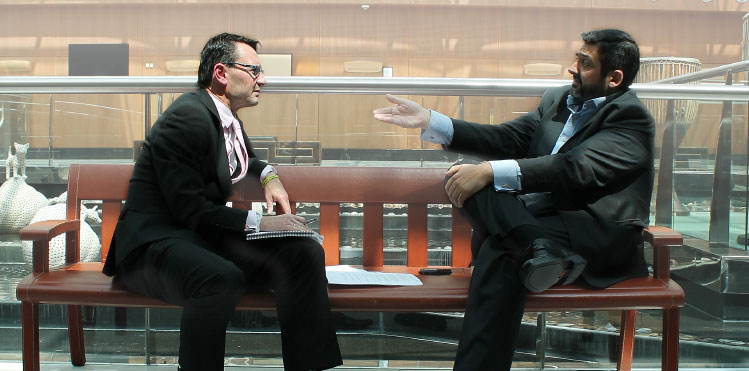
Alex Cruz, CEO of Vueling, in conversation with Airport Business
We don’t like low cost airports and low cost terminals.” It’s not exactly what you expect to hear from Alex Cruz, CEO of Vueling, the boss of Europe’s fourth-largest low cost carrier (LCC), which expects to overtake Norwegian to become Europe’s #3 LCC within the next year (you can probably guess which LCCs are #1 and #2). Vueling is on a major growth spurt, taking in lots of new leased aircraft every year, and dramatically opening a major new base in Rome this spring. On the eve of the airline’s 10th birthday (1 July), Vueling will be operating 90 aircraft, up from 38 in 2010, and serving close to 300 routes.
Cruz doesn’t much like the LCC label either. “In recent times commentators haven’t known which category to put us into – ‘LCC’ or ‘hybrid.’ I think ‘extremely productive’ might be a better one.” Cruz is referring to the noticeably changed dynamic among all the big ‘non-legacy’ airlines who have decided that they want to raise average yields significantly by putting the business traveller at the core of their model – the same staple passenger which most airlines relied upon for ultimate profitability for 50 years before the invention of the LCC.
“We’re definitely serving the business traveller – they’re 39% of our customers – and a much bigger slice of the revenues and profits. Airports who want to win our business – and get the benefit of serving and selling things to our customers – need to appreciate what service level we know these customers expect. For these reasons we insisted on using the full service facilities at Schiphol and not the low cost offering. Of course, this doesn’t mean that we don’t take airport fees into account; ultimately, we have the best relationships with those airports that have similar commercial pressures to us.”
Airport Business met Alex Cruz at Heathrow, the headquarters of International Airlines Group (IAG) which also comprises British Airways and Iberia. IAG bought control of Vueling in 2013 – previously its other IAG stable mate, Iberia, had a large but non-controlling 48% holding.
According to IAG the takeover allowed Vueling to: “Retain its individual brand and current operations, while the airline’s customers benefit from a larger combined network.” It also means that Cruz reports directly to IAG CEO Willie Walsh. “It’s a high pressured environment to put it mildly. But that’s in the genes of Vueling anyway, having originally grown from a start-up. We have clear profitability and growth objectives and the rest of IAG, starting with Willie Walsh, understand Vueling’s business model. Specifically, Willie’s experience as boss of Aer Lingus shows: Walsh knows very well what is required to manage a company of our size and he supports all of our efforts to become a better airline. He knows we have a lot of competitive pressures coming from the market.”
After becoming part of IAG it quickly became apparent this “market” was about to become a lot bigger for Vueling. IAG ownership gave Vueling access to a much larger pool of all kinds of resources, and IAG announced in August 2013 that an additional 120 A320s would be deployed to Vueling 2015-2020. Big ambitions were in prospect and it did not take long to find out where these lay.
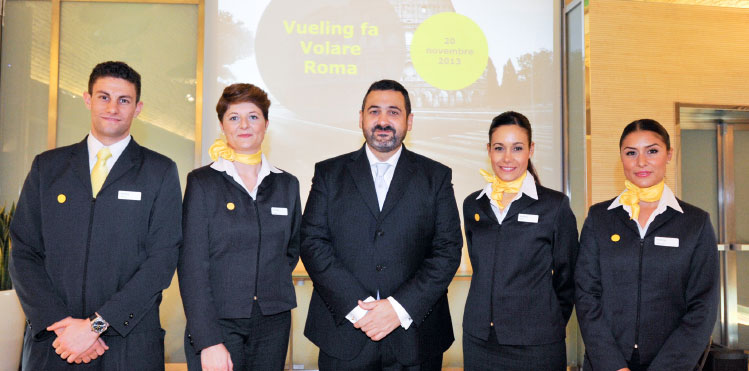
“Rome is a very big bet; we can really make something out of Rome.” Cruz says he’s thoroughly enjoying establishing a major Italian business: “Italy has a lot of parallels with Spain… the cultural closeness is very important – the Italians’ think similarly to us and have a great work ethic, I am not just talking about stereotypes – obviously Vueling is not just Spanish or Spain – but we’re working towards our Italian citizenship.”
Brussels is a major airport which became a Vueling base this spring, albeit with only one aircraft so far. “Brussels is a small base. We have more important bases in Paris, and even in Florence, where we have two aircraft. But Brussels got us a lot of publicity and attention, especially as the Irish [Ryanair] followed us there. But it’s a nice place – we can be a little bit flexible with the capacity, and try some new routes.”
With growth operations in Brussels, Rome, Paris, Florence and Amsterdam, Vueling will not just focus in non-Spanish markets. “We continue to grow in Spain with an emphasis on non-domestic traffic”, remarks Cruz. Vueling expects to continue slowly building connectivity with northern airports and pushing healthy growth in southern and island airports. “Spain continues to be a fantastic holiday destination and Vueling is consolidating itself as a significant ‘sun and beach’ player in Italy, Germany and France while we also grow in the UK and Scandinavia.”
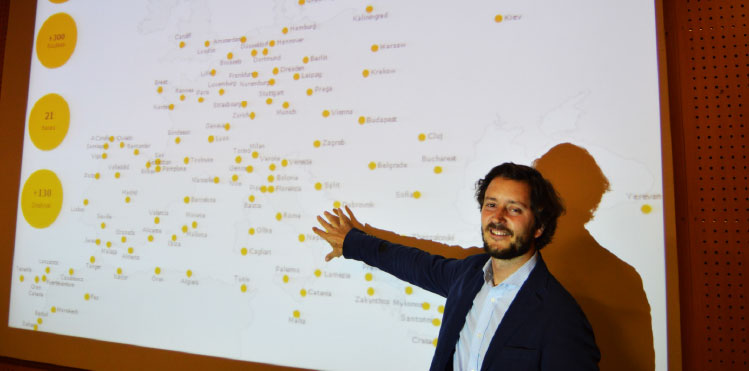
Vueling’s Director of Network Planning, Strategy and Slots, Javier Suarez, sweeps his hand across the 2014 Vueling route map to illustrate just how much new capacity the new Rome base has delivered – Vueling’s systemwide capacity is up 31% this summer led by with Italy +143% more seats.
Rome transformation “won’t be built in a day”
In some contrast Cruz lights up and enthuses about Vueling’s new Rome base: “Rome is a very big bet; we can really make something out of Rome.” Indeed Vueling’s Rome’s Fiumicino expansion is seismic: It comprises the summer 2014 introduction of 24 new routes (seven domestic and 17 international) and the decision to base a total of eight Airbus aircraft at the airport. Of the 24 new destinations only three (all in Spain) are not already served by one or more carriers – including 11 by Ryanair. But the base is especially challenging to Alitalia for which Rome is a ‘last stand’ to which it had already retreated from Milan (Malpensa is a major easyJet base; while Milan Bergamo is similarly for Ryanair). Alitalia has long had to put up with a significant Ryanair base at Rome Ciampino but, once again, Vueling’s move on Rome is a frontal assault on Alitalia’s business traveller market.
“France has always been our second biggest market and Paris our biggest base outside of Spain, but now Rome will be. Rome has a lot of parallels with Barcelona where the whole Vueling story started. Indeed at the end of this year Rome will be about the size that Vueling was in Barcelona by about 2009. We will also be the #2 airline after Alitalia and competing very much with them through domestic and international products by offering frequent flyer programmes and many other business products – all the things people had with Alitalia and they want them again.” (Although it is worth noting that Vueling is not a member of the oneworld alliance, even though it does codeshare with Iberia on the vast majority of its routes.) “Rome was not built in a day and neither was its transformation brought about when we turned up with our planes in a single day. We’re building, but we do have a fantastic summer in prospect.”
Cruz also says he’s thoroughly enjoying establishing a major Italian business: “Italy has a lot of parallels with Spain… the cultural closeness is very important and a great benefit – the Italians’ think similarly to us and have a great work ethic, I am not just talking about stereotypes – obviously Vueling is not just Spanish or Spain – but we’re working towards our Italian citizenship – to be accepted by the people with a reliable product, but at very reasonable prices.”
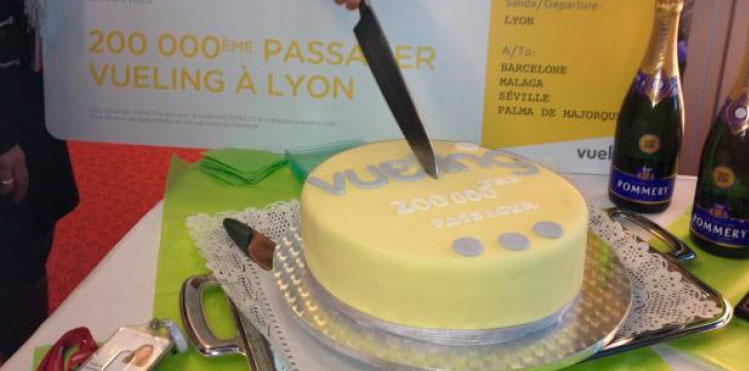
“We’re definitely serving the business traveller – they’re 39% of our customers – and a much bigger slice of the revenues and profits. Airports who want to win our business – and get the benefit of serving and selling things to our customers – need to appreciate what service level we know these customers expect.”
Bigger Vueling: Which airports will get new routes?
According to anna.aero’s analysis of Innovata/Diio Mi data for August 2013 and August 2014, Vueling’s capacity is up 31% this summer, with Italy (+143%), Belgium (+111%) and Greece (+169%) seeing particularly rapid growth. The first two are driven by the airline’s expansion at Rome and Brussels. Overall, since last summer, Vueling has started operations in eight new country markets: Armenia, Cyprus, Estonia, Hungary, Poland, Senegal, Serbia and Tunisia.
However, with the new bases, Cruz thinks that the bulk of the route growth will centre on new services between existing airport operations. “It’s fair to say that we have put most of the dots on the map, that there won’t be a great increase in destinations, but with the new bases we’ll do a lot of dot connecting. It’s true that there are ‘white spots’ – with 125 different airport destinations on our system we have a bit of everything in terms of north-south, east-west, business, leisure, and highly liberal, and highly regulated. We’re not big in certain markets for obvious reasons – for instance a lot of people are very excited about Turkey, but for us it’s an outbound and leisure market which has yet to prove it can generate a healthy traffic base from our key markets like Barcelona, and we don’t fly to Dublin yet where we’d be competing with the incoming airlines.”
Routes to Russia/CIS/Eurasian Economic Union
Like many airlines the crisis in Ukraine has meant that Vueling has had to postpone some very positive route developments which were just about to happen – Vueling was due to launch three services to Ukraine from Barcelona this year – Kiev Zhuliany went ahead on 12 April, but not services to the eastern Ukraine cities of Kharkov on 4 June and to Donetsk on 5 June. However, Cruz says that despite the unrest, performance of the new Kiev route has been “very good” and he is keen to resume expansion when the situation normalises.
Indeed Vueling is very experienced in the Russian market having first begun services to Moscow Domodedovo in 2009. Reporting that load factors are “all in the nineties” from Russia and the CIS/Eurasian Economic Union countries, Cruz says that there are substantial opportunities: “Russia is still a very old fashioned, regulated bilateral market, although there are some flexibilities from second cities.” In this respect Cruz hopes to soon add Rome-St Petersburg and Florence-Moscow: “We want to start these as soon as possible. To appreciate the size of this growing opportunity, when we started Barcelona-Moscow services exactly five years ago, we were operating 3-4 weekly frequencies. Now we’re doing the equivalent of that every day from across the Vueling network.”
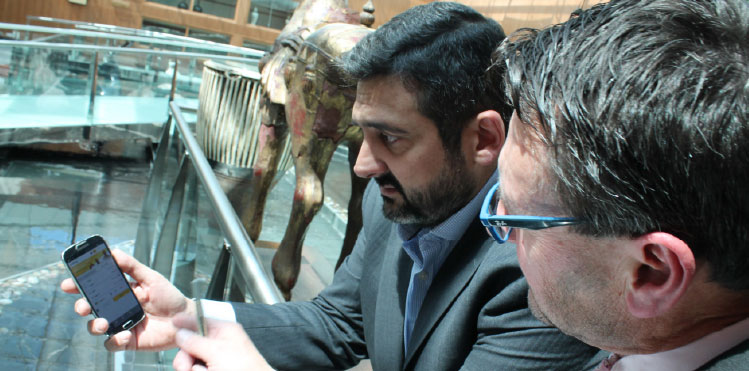
“In terms of technology we have what we need; the industry is just not using it. There should be a single-entry point, and for my customers I frankly think that will be the Vueling app and nobody else’s; we fully expect it to develop into a tool covering the whole journey, including travel to and from the airport, and the airport experience itself.”
Vueling was born into the Spanish domestic travel market at a time when it was being revolutionised by the high speed train, and this is clearly a big influence on Cruz: “From a customer experience perspective at the station vs. airport, the high speed train experience beats us every time – you can arrive at the station just a few minutes before your train, the security is not as onerous, and there is much more space.” Cruz agrees that the threat is largely structural and not related to all of Europe’s high speed rail providers and to only specific markets, but that high speed rail serves as both a warning, as well as competitive example, and ultimately “a potential business opportunity through partnerships.” He also thinks that, in response, one of the key areas of airport improvement should be centred on application of traveller technology and airport commercial offers.
“In terms of technology, in essence, we have what we need; the industry is just not using it. If I arrive at an airport, and there have been delays, and I need to find out which train to catch next and re-book, I want to avoid multiple platforms, so there should be a single-entry point, and for my customers I frankly think that will be the Vueling app and nobody else’s. For the first time Vueling’s IT budget will now see much more spent on our mobile application than the web platform – we fully expect our app to develop into a tool covering the whole journey, including travel to and from the airport, and the airport experience itself.”
Cruz on improving airport technology and shopping
Cruz’s clear implication is that airports need to cooperate more with airlines like his if they hope to play any role at all: “We know everything about the passenger – when they fly, where they are going, and the booking tools they use etc etc. We all need to think outside of the box – connectivity is one thing – we have had that for some time. But then we have to find out which ideas will make money and recover the costs of the hardware and programming. To be honest I think we know what we’re doing at Vueling, we have the innovation DNA.”
And while talking to Airport Business in the shadow of Heathrow – arguably something of a ‘university’ in how to merchandise to passengers – Cruz is still critical of airport commercial enterprise on two key fronts: “I agree that airports need to do everything possible to maximise revenue, but every time I travel I am astonished that there is never anything to buy in the boarding gate where there is so much significant dwell time. This is such a missed opportunity. And, while we’re talking of missed opportunities, airports have very patchy Wi-Fi and vastly differing models of supply.” But even these points are overwhelmed by his final message: “I have also spoken to airports many times about working together with us to find structural ways in which we can jointly increase passenger spend. So far, only small initiatives with individual airports seem to work out but I’m still optimistic that further opportunities will be developed jointly in the near future.”
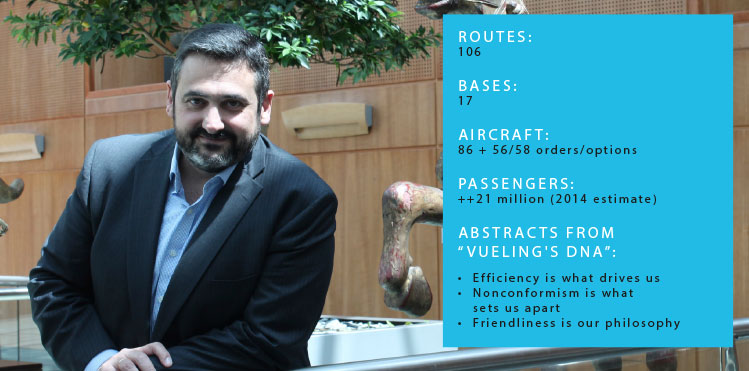
“I have also spoken to airports many times about working together to jointly increase passenger spend. So far, only small initiatives seem to work out but I’m still optimistic that further opportunities will be developed jointly in the near future.”







